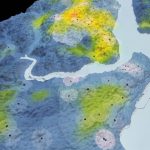The goal of data visualization is to give users insight into complex data using the visual sensation. Until recently, research has focused on improving traditional computer interaction techniques, however, lack to address collaborative work and immediate analysis start without extensive tool training.
Humans are eager to explore their surroundings by touching and not by mouse and keyboard, but traditional computer human interaction techniques and visualizations do not fulfill this requirement.
Literature surveys reveal that spatial displays can address some of the short comings of physical visualizations and improve interaction issues. To do this, we are planning to build a data visualization system which will project computer generated images on top of active and passive physical visualizations printed by a 3D printer. Moreover, there will be transparent displays at each side of the system displaying different information. After this research activities, we are planning to build a visualization system where physical visualizations along with spatial displays can enable users to collaborate to analyze complex data sets. To the best of our knowledge, there is no such a system and there is a lack of research in the area of data analysis focusing on physical visualizations.
Data visualization in the form of sculptures is an interesting and emerging area of research. While computer-based 2D and 3D graphical displays are quite common, data sculptures are getting more attention as visualization aids, as they offer an additional dimension for further analysis of data. In this research, we investigate new ways of visualizing Akbank’s credit card transaction data in the form of simple 3D-printed sculptures. These sculptures not only provide additional perspectives of interpretation on multi-dimensional data, but also allow a much more engaging and collaborative discussion environment for analyzing data.








